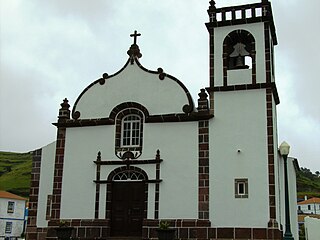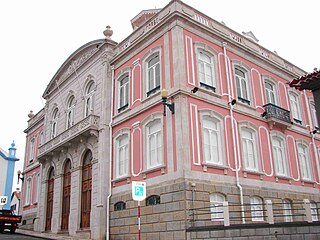
Matriz is a freguesia in the municipality of Horta, in the Portuguese Azores, which is part of the urbanized core of the city of Horta. The population in 2011 was 2,562, in an area of 1.81 km². It is the smallest and most populous parish on the island. It contains the localities Matriz and Dutras.

The Palace Bettencourt is a former residence of the Bettencourt family, and current seat of the public library and regional archive, in the civil parish, in the municipality of Angra do Heroísmo, in the Portuguese archipelago of the Azores.

The Angra do Heroísmo City Hall is a medieval structure constructed to house the municipal council/authority, situated in the civil parish of Sé, municipality of Angra do Heroísmo, on the Portuguese archipelago of the Azores.

Manor of Madre de Deus is a historic former residence of the Bettencourt family in the civil parish of Sé, in the municipality of Angra do Heroísmo, in the Portuguese archipelago of the Azores.

Fort of Santa Cruz, is a 16th-century fortification located in the civil parish of Angústias, municipality of Horta, on the island of Faial in the Portuguese Azores. Occasionally referred to as the Castelo de Santa Cruz by locals, it is situated in the historic centre of the city, on the edge of Horta Bay. It was constructed to work in conjunction with the Fort of Bom Jesus at the mouth of the Ribeira da Conceição and Fort of Greta along the coast of the extinct spatter cone Monte da Guia, to defend the entrance to the harbour and southern access to the Bay.

The Hermitage of Nossa Senhora dos Anjos, is a hermitage/chapel located in the village of Anjos, on the northcoast of the civil parish of Vila do Porto, on the island of Santa Maria in the Portuguese Azores.

The Convent of São Francisco, originally designated the Convent of Nossa Senhora da Vitória, located in the Largo of Nossa Senhora da Conceição, in the civil parish of Vila do Porto, municipality of the same name on the island of Santa Maria, in the Portuguese in the Azores.

The Convent of São Pedro de Alcântara is a Baroque convent and church complex in the civil parish of São Roque, in the municipality of the same name, in the Portuguese archipelago of the Azores.

The Convent of Caloura is a Portuguese 16th-century convent located in the civil parish of Água de Pau, in the municipality of Lagoa, on the island of São Miguel in the archipelago of the Azores.

The Church of Santa Bárbara is a Roman Catholic church in the civil parish of Santa Bárbara, municipality of Vila do Porto, in the archipelago of the Azores. Located in the valley of the same name, the parochial church of Santa Bárbara was constructed sometime in the early 15th century and served the impoverished parish throughout its history, supported by personal donations and community assistance.

The (Old) Church of São Mateus da Calheta are the ruins of a 16th-century church situated along the coast of the civil parish of São Mateus da Calheta, municipality of Angra do Heroísmo, on the Portuguese island of Terceira, in the archipelago of the Azores. Reconstructed at the end of the 17th, or beginning of the 18th, century, the church was abandoned after a hurricane caused severe damage. The interior includes a baptismal font dating to the 16th century, although largely an open air ruin; the structure has experienced several interventions throughout the centuries, with the building painted and maintained in its post-hurricane state.

The Residence Silveira e Paulo is located on Rua da Conceição, in the civil parish of Nossa Senhora da Conceição, in the historic centre of Angra do Heroísmo, Terceira Island, in the Portuguese archipelago of the Azores. Completed in the style of the late 19th century, the residence is one of the more notable examples of Azorean civil construction in the transition between 19th and 20th centuries.

The Convent of Esperança was a former Christian religious building, situated in the Historical Centre of Angra do Heroísmo, in the civil parish of Sé, on the island of Terceira, in the archipelago of the Azores.

The Convent of São Francisco (Portuguese: Convento de São Francisco), also known as the Convent of Saint Francis of Assisi or the Convent of Our Lady of the Rosary, is a convent in the civil parish of São Pedro, in the municipality of Vila Franca do Campo, in the Portuguese archipelago of the Azores. Originally a monastic building housing Franciscan friars, the building was converted into a lodgings at the turn of the century.
The Convent of Nossa Senhora da Conceição is a former convent situated in the civil parish of Sé, in the historic centre of the municipality of Angra do Heroísmo, in the Portuguese archipelago of the Azores.

The Bartizan of Porto Pim is a medieval watchtower located in the civil parish of Angústias, in the municipality of Horta.

The Church of Nossa Senhora dos Remédios is an 18th-century church located in the civil parish of Fajãzinha in the municipality of Lajes das Flores, in the Portuguese island of Flores, in the archipelago of the Azores.
The Church of São Caetano is a 17th-century church located in the civil parish of Lomba in the municipality of Lajes das Flores, in the Portuguese island of Flores, in the archipelago of the Azores.
The Church of Benditas Almas is a 19th-century church located in the civil parish of Caveira in the municipality of Santa Cruz das Flores, in the Portuguese island of Flores, in the archipelago of the Azores.

The Church of Nossa Senhora da Conceição is an 18th-century church located in the civil parish of Santa Cruz in the municipality of Santa Cruz das Flores, in the Portuguese island of Flores, in the archipelago of the Azores.


















